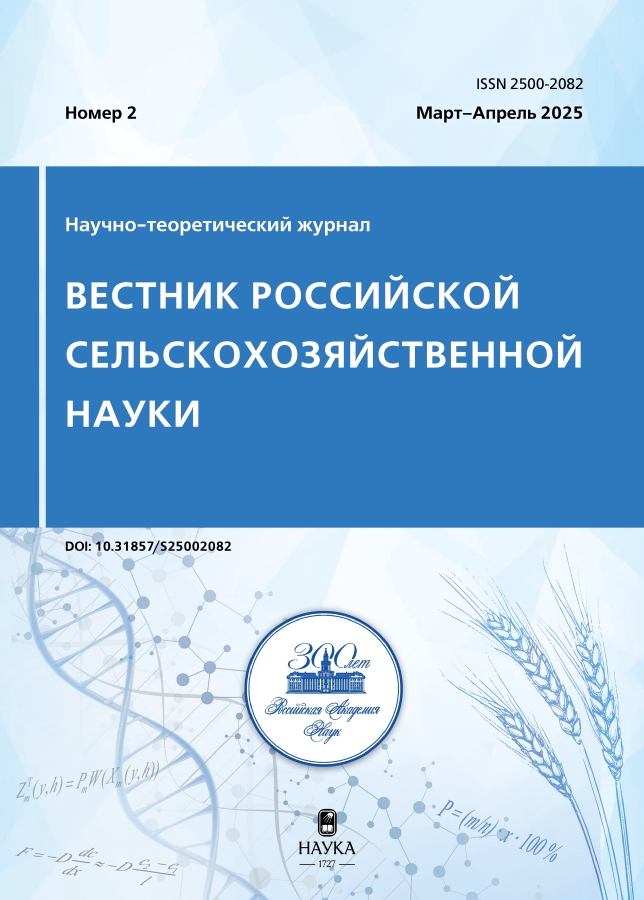Influense of pre seeding electronic irradiation to the spring wheat sedlings and deseases insedence indicators
- Авторлар: Loy N.N.1, Sanzharova N.I.1
-
Мекемелер:
- Russian Institute of Radiology and Agroecology of National Research Centre «Kurchatov Institute»
- Шығарылым: № 2 (2025)
- Беттер: 21-25
- Бөлім: Crop Production and Selection
- URL: https://vietnamjournal.ru/2500-2082/article/view/684942
- DOI: https://doi.org/10.31857/S2500208225020058
- EDN: https://elibrary.ru/HUNBEI
- ID: 684942
Дәйексөз келтіру
Аннотация
. In the laboratory conditions of the climate chamber, a model experiment was conducted to study the effect of pre-sowing low-energy electron irradiation of seeds on the development indicators of spring wheat seedlings of the Iren variety. In the experiment, seeds naturally affected by root rot (pathogens Drechslera teres and Fusarium spp) were used. Irradiation in the range of 1–5 kGy was carried out on the electronic accelerator “Duet” at the ISE SB RAS, the radiation power is 100 100 Gy/pulse, at two electron energies – 100 keV (mode 1) and 120 keV (mode 2). The seeds were germinated in rolls of filter paper 9 and 12 days after irradiation. Unirradiated seeds served as a control. The repetition in the experiments is threefold. During the irradiation period of 9 days, there was a significant 1% increase in laboratory germination at doses of 2 and 4 kGy (electron energy 100 keV, mode 1) and at doses 1 and 4 kGy (electron energy 120 keV, mode 2), root lengths at doses 1 and 5 kGy (mode 1) by 4.3 and 3.4% and at doses of 1–3 kGy (mode 2) by 4–5% and there is no significant effect on the content of free proline and catalase activity in 7 daily wheat seedlings. During the irradiation period of 12 days, irradiation stimulated the length of the sprout at a dose of 2 kGy (mode 1) by 11.2%, and at doses of 5 kGy (mode 1) and 2–5 kGy (mode 2) it depressed by 12.2 and 20.4–32%, respectively. At doses of 3 and 5 kGy (mode 2), the length of the roots of seedlings decreased by 7.6 and 6.1%. Irradiation caused an increase in the crude mass of seedlings at doses of 1-5 kGy (mode 1) by 6.7–11.7% and at doses of 1 and 2 kGy (mode 2) by 8.7–17.8%, and at doses of 3–5 kGy (mode 2), on the contrary, a decrease of 21.6–32.3%. Taking into account the infestation of 7 daily wheat seedlings with diseases when laying at different times after irradiation of seeds showed that during the irradiation period of 12 days, the development of diseases was lower than during the period of 9 days.
Толық мәтін
Авторлар туралы
Nadezhda Loy
Russian Institute of Radiology and Agroecology of National Research Centre «Kurchatov Institute»
Хат алмасуға жауапты Автор.
Email: loy.nad@yandex.ru
PhD in Biological Sciences
Ресей, Obninsk, Kaluga regionNatalia Sanzharova
Russian Institute of Radiology and Agroecology of National Research Centre «Kurchatov Institute»
Email: loy.nad@yandex.ru
Grand PhD in Biological Sciences, Corresponding Member of the RAS
Ресей, Obninsk, Kaluga regionӘдебиет тізімі
- Bissvanger H. Prakticheskaya enzimologiya. M.: BINOM. Laboratoriya znanij, 2013. 328 s.
- Vojtova L.R. Analiz semyan yachmenya na zarazhennost’ kornevoj gnil’yu // Zashchita rastenij. M.: Kolos, 1980. № 2. S. 48–49.
- GOST 12038-84 Gosudarstvennye standarty Soyuza SSR. Semena sel’skohozyajstvennyh kul’tur. Metody opredeleniya kachestva. Ch. 2. M., 1995. S. 44–101.
- GOST 12044-93 Mezhgosudarstvennyj standart. Semena sel’skohozyajstvennyh kul’tur. Metody opredeleniya zarazhennosti boleznyami. M., 2011. 57 s.
- Sanin S.S. Zashchita pshenicy ot boleznej v sovremennyh intensivnyh tekhnologiyah ee vozdelyvaniya v Central’nom regione Rossii // Zernobobovye i krupyanye kul’tury. 2013. № 2 (6). S. 33–40.
- Chernobrovkin T.V., Vazirov R.A., Sokovnin S.Yu. Vliyanie oblucheniya nizkoenergeticheskim elektronnym puchkom na prorastanie i rost vida Triticum L. // Sovremennye problemy radiobiologii, radioekologii i agroekologii. Sbornik dokladov IV Mezhdunarodnoj nauchno-prakticheskoj konferencii. Obninsk, 2021. S. 103–107.
- Aebi H. Catalases Physiological and Biochemical Effects of 24-Epibrassinolide on Heat-Stress Adaptation in Maize (Zea mays L.) // Methods of Enzymatic Analysis. 1971. Vol. 3. P. 273–286.
- Bates L.S. Rapid determination of free proline for water stress studies // Plant Soil. 1973. Vol. 39. P. 205–207.
- Isemberlinova A.A., Poloskov A.V., Egorov I.S. et al. Influence of a pulsed electron beam on the sowing quality of wheat // Key Eng. Mater. 2018. Vol. 769. P. 172–180. https://doi.org/10.4028/www.scientific.net/KEM.769.172.
- Vorobyov M.S., Koval N.N., Sulakshin S.A. An electron source with a multiaperture plasma emitter and beam extraction into the atmosphere // Instrum. Exp. Tech. 2015. Vol. 58, № 5. P. 687–695.
Қосымша файлдар















